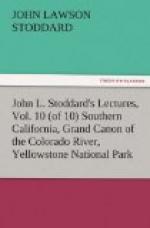[Illustration: A CHRISTIANIZED Indian.]
[Illustration: The mission bells.]
The old town of San Diego, four miles north of the present city, is now almost abandoned. Only a dozen adobe buildings kept in fair repair, and as many more in ruins, mark the site. The little chapel is still used for worship, and from an uncouth wooden frame outside its walls hang two of the old Mission bells which formerly rang out the Angelus over the sunset waves. My guide carelessly struck them with the butt of his whip, and called forth from their consecrated lips of bronze a sound which, in that scene of loneliness, at first seemed like a wail of protest at the sacrilege, and finally died away into a muffled intonation resembling a stifled sob. Roused by the unexpected call, there presently appeared an Indian who looked as if he might have been contemporary with Methuselah. No wrinkled leaf that had been blown about the earth for centuries could have appeared more dry and withered than this centenarian, whose hair drooped from his skull like Spanish moss, and whose brown hands resembled lumps of adobe.
[Illustration: An aged Squaw.]
“I am glad to have you see this man,” said the guide, “for he has rung these bells for seventy years, and is said to be more than a hundred years old.”
I could not obtain a portrait of this decrepit bell-ringer, for many Indians are superstitiously opposed to being photographed; but I procured the picture of an equally shriveled female aged one hundred and thirty who might have been his sister.
[Illustration: Relics of an ancient race.]
[Illustration: “Ecstatic bathers.”]
“This,” remarked my guide with a smile, “is what the climate of San Diego does for the natives.”
“The glorious climate of California” has been for years a theme of song and story, and a discussion of its merits forms one of the principal occupations of the dwellers on the Pacific coast. It is indeed difficult to see how tourists could pass their time here without this topic of conversation, so infinite is its variety and so debatable are many of the conclusions drawn from it. It is the Sphinx of California; differing, however, from the Sphinx of Egypt in that it offers a new problem every day. The literature that treats of the Pacific coast fairly bristles with statistics on this subject, and many writers have found it impossible to resist the temptation of adorning their pages with tables of humidity, temperature, and rainfall. Some hotels even print in red letters at the top of the stationery furnished to their guests:
“The temperature to-day is ——.”
Among the photographs of San Diego are several which represent groups of ecstatic bathers, ranging from small boys to elderly bald-headed gentlemen, apparently ready to take a plunge into the Pacific; while beneath them is displayed the legend, “January 1, 18—.” Candor compels me, however, to state that, as far as I was able to ascertain, these pictured bathers rarely pay a New Year’s call to Neptune in his mighty palace, but content themselves in winter with going no further than his ante-chambers,—the sheltered, sun-warmed areas of public bath-houses.




